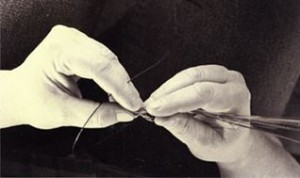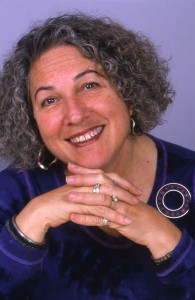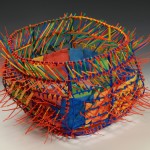A discussion among members of the Bay Area Basket Makers about their ideas on exhibiting, promoting and selling their creations.

A basket begins
Where do we exhibit and sell our art? Do we remain local, participating in guild-organized shows and art exhibitions within our communities, or do we strive to gain national reputations by participating in juried shows in other states, hoping to find galleries to “rep” our work? How do we decide what to charge for our art? And what is it that we most hope to gain from sharing our creations with others?
I raised these questions with fellow guild members of the Bay Area Basket Makers (BABM), and the answers and outlooks were as varied as our membership. Nevertheless, general themes popped up no matter who responded:
The reason we create is because it’s fun. When it’s all work & no fun, it’s time to move on…
We exhibit and sell primarily to share our love & passion for the art with our local communities, and to promote handweaving as a nourishing and imaginative form of art and craft.
That said, here is how some of our weavers market & sell their art:
ON EXHIBITING:
Emily Dvorin :

Emily Dvorin
I have a theory about exhibiting my work: show as much as you can and get your name out there. Establishing a reputation and a name is important. “Branding” is what it is called in business. It takes time, perhaps years, but it works. For many years I have grabbed at opportunities to show across the country in themed shows, in small museums, and in fiber or basketry or sculpture-specialized exhibits. I choose the calls for entry carefully.

Basket by Emily
Andrea DuFlon:
I keep track of the fiber shows in the U.S., monitoring them through magazines like Fiberarts and NBO (National Basket Organization) Quarterly, and filing them by entry dates in a notebook. Once your work has been exhibited and printed in exhibition catalogues, galleries, which are always looking for new artists, may begin to take notice and contact you, or even offer to represent you. Look through the magazines and organization websites for “Call for Entries.” I think I’ve had good luck being accepted because my work, in terms of form and use of materials, is unusual.
Gail Ruvalcaba:
The most successful forums I’ve found for exhibitingwork are local fine arts events. You might have to be a member of the sponsoring organization, such as the Livermore Art Association or the Pleasanton Art League. The local shows are juried, but once accepted, it’s easier to gain entry the next year. Through these art groups, I also hear about other local opportunities to exhibit.

Kelp Basket by Gail Ruvalcaba

Gail Ruvalcaba teaching student
Jane Woolverton:
In addition to my Hunters Point Open Studio exhibitions, I make donations to raffles and auctions for non-profits such as California Lawyers for the Arts and Artspan to publicize my work. In the past I’ve also had my work published in the American Art Collection, a Bay Area based juried catalog where, if accepted, you pay a minimal fee for publicity, and the book is sent out to galleries across the country.
When exhibiting solo at the Maker Faire and Fungus Fair (using mushroom dyes), or as a group with my guilds at galleries, shows and museums, I find that sharing my passion and the sense of community it gives me is the most rewarding. Sales and teaching opportunities evolve from these communal experiences affirming that sparks have flown, and fueling my fire for fiber art.

Mushroom dyed scarves by Gayle Still

knotted basket sewn on shirt by Gayle Still
ON SELLING:
Emily Dvorin:
I sell well in themed fiber shows. And I do two “booth” shows: the Marin Art Festival, and the Mill Valley Fall Arts Festival. I always sell well at these, partly because I am there to talk about the work, and partly because of the [extensive] marketing for each show. I also sell at my Open Studios, held twice a year, because of the personal contact with people who attend.
Orna Pascal:

Orna Pascal and basket
I have to admit that I really loved my wholesale business where someone else did the selling! However, basketry and fine art/craft just does not lend itself well to that. Being part of my local community has worked best for me, as I prefer small and medium venues. Currently, I have a studio at the Coal Shed in Vallejo and participate in Open Studios and all other shows we do there. Every year I have a booth at the Napa Valley Holiday Extravaganza and our BABM show at last year’s Celebration of Craftswomen was also goodI do find that when I work on a basket at shows there is immediate interest and often people are motivated to buy on the spot. Online store (e.g. etsy) have tremendous potential and one of these days I’m going to try them as well!
ON GUILD SPONSORED EXHIBITIONS AND SALES:
Andrea DuFlon:

"Attatchment" by Andrea DuFlon
BABM organized and curated a show at the Gualala Arts Center for years until a change in center administration and politics brought an end to this exhibition. Gualala was unique. Our annual show was perfectly timed to coincide with a yearly tour of local homes, and was immensely profitable to our members as well as for the Art Center. Our guild did all the set-up, labeling, curating, publicity, and transport; the Art Center provided a clean exhibit space and advertised to their membership.
Jill Stanton:
This past year, BABM exhibited at the Celebration of Craftswomen, a long-standing festival held at Fort Mason in San Francisco. Our 2-booth space exhibited work of some 21 BABM members, and a number of members made substantial sales. The downside was the considerable cost, which our Guild absorbed, that the festival organizers charged for everything from booth space, to tables, pipe and drape. Nevertheless, the public response was heartwarming—we were repeatedly complimented on the beauty, variety and uniqueness of our display—and we felt that the show served an important educational function in introducing both our guild and our art to the community.

BABM Display at Celebration of Craftwomen

Jill Stanton at Celebration of Craftwomen
Later this year BABM will exhibit at another local venue—The Thoreau Center for Sustainability in the Presidio in San Francisco. While the space is free, again we will be responsible for the entire set-up, and, this not being a festival venue, we don’t expect to sell much, if at all. The goal at the Thoreau Center exhibit will primarily be to introduce our art to a much broader audience.
ON PRICING OUR ART:
Andrea DuFlon:
You can’t base the price of a piece on how many hours it took to make. For me, the dollar value reflects a combination of experience, uniqueness, skill and intent. And, craftspeople and artists who have been exhibiting and selling for a long time shoud have prices that reflect this longevity. When we’ve done group shows, I believethat we’ve sold ourselves short; I don’t think we charge enough for our work. When we exhibit as a group, I think it would help us to create pricing guidelines that we all agree upon so that we’re not undercutting each other.
Emily Dvorin:
Knowing what to charge for my work is a challenge. I decide prices based on the time it took me to make, what the market will bear, and the originality of the concept and execution. I long ago realized that I would not get paid for all the idea time and learning time and set up time and volunteer time I put out. It all informs my art and that is what is important.
Orna Pascal:
When we price, we have to deal with our attachment to the work. There is an element of mystery to pricing and selling. Those pieces that I price highest have some transcendent quality—I see them as a product of my life’s work. Sometimes, after taking into consideration your time and skill, you just have to put a price tag on and see how customers react.
One year, one show, you might sell a lot of a particular kind of art, and the next time not. It’s important to look back at the end of the year, rather than after each show, to get perspective. In general, we don’t get what we deserve, but money isn’t the only important return. And you have to remember that even if you didn’t make sales, there is usually something fortuitous that comes with being in a show—you learn of new venues, prospective customers remember you at a later date, or maybe you just make new friends.
ON THE IMPORTANCE OF HAVING A WEBSITE:
Emily Dvorin:
I believe that the best promotion of my work, the most successful way to get to viewers, customers, and galleries, is my website. I have an informative, in depth website, with galleries, a blog and even a video of me talking about my work. It is my portfolio. I try hard to keep it updated and current, with links to other organizations and BABM.